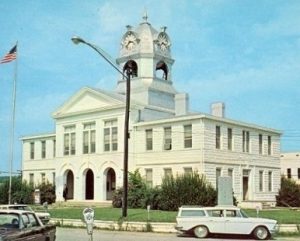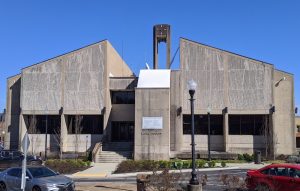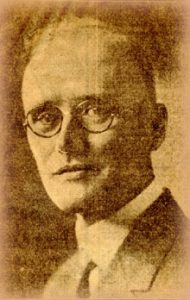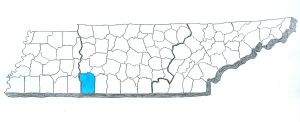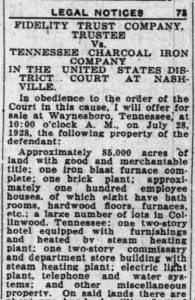
Waynesboro is also one of many Tennessee counties that once had a General Shoe factory. General Shoe (or “Genesco”) was at one time the largest apparel company in the world, with shoe factories all over the southeast. Here are the employees of General Shoe’s Waynesboro plant in 1954.
Normally the courthouse itself isn’t one of the more interesting stories in a county. But it is in Wayne County.
In 1972 the old courthouse burned. Originally, Wayne County officials were going to move the courthouse away from the Waynesboro town square. But by the time the Nashville architectural firm, Yearwood and Johnson, had come back with a rather unusual modern design, the decision had been made to rebuild on the site of the old courthouse.
Today people who drive through Waynesboro do a double-take when they see the reinforced concrete courthouse. It is, without question, the most unusual courthouse in Tennessee.
Because the river used to flood, there aren’t very many towns where the downtown is locate right on top of the Tennessee River. However, the Wayne County town of Clifton is right on top of the river — in fact, there are old buildings and parks right along Water Street in Clifton, with great views of the river below. Here is a view of the Tennessee River in Clifton. A ferry that took people to the other side of the river used to operate here until 1998.
And, speaking of Clifton: By many accounts, T. S. Stribling was America’s greatest author in the 1920s and 1930s. He was born in Clifton and lived here on and off throughout his life (although Florence, Alabama – not far from here – also claims him). Starting in 1930, Stribling published a trilogy about life in the South, under titles The Forge, The Store, and Unfinished Cathedral. The Store won the Pulitzer Prize in 1933.
Not all of his fellow southerners were happy with his depiction of life in the South, the way he attacked injustice, and the way he wrote about race relations. Some people today say that it was T. S. Stribling’s novels that “destroyed the myth” of the old South, carving the way for some of the changes that took place after World War II (such as desegregation).
